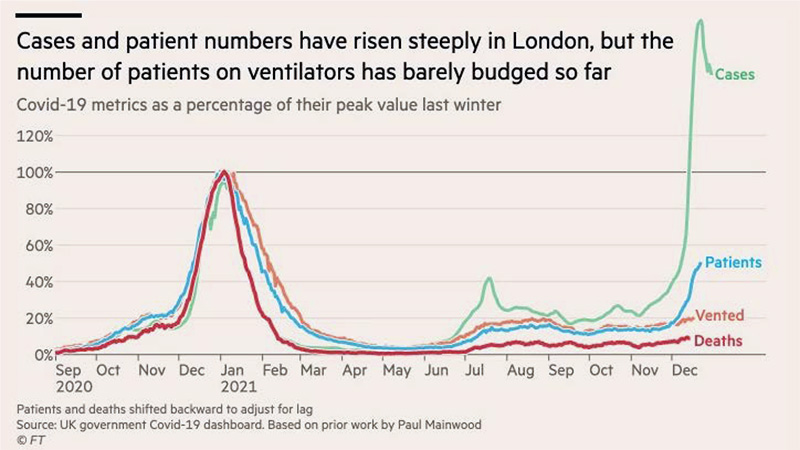From the Dean: Omicron trends and contingency plans
 As we enter the third calendar year of SARS-CoV-2 (ugh), I see storm clouds close by, and the real possibility of brighter skies by the spring. First to the storm clouds. The omicron variant, as you know, is highly contagious and spreading very rapidly. The chart above is from the Financial Times and shows the incredibly rapid and large growth in the number of test-positive individuals in London, U.K. (Cases in green), the number of hospitalized people (Patients in blue), the number of people on respirators (Vented in orange), and the number of Deaths in red.
As we enter the third calendar year of SARS-CoV-2 (ugh), I see storm clouds close by, and the real possibility of brighter skies by the spring. First to the storm clouds. The omicron variant, as you know, is highly contagious and spreading very rapidly. The chart above is from the Financial Times and shows the incredibly rapid and large growth in the number of test-positive individuals in London, U.K. (Cases in green), the number of hospitalized people (Patients in blue), the number of people on respirators (Vented in orange), and the number of Deaths in red.
What is striking is the important dissociation between cases, serious illness resulting in respirator support, and deaths. This is especially so for fully vaccinated individuals, and note, in particular, the incredibly wide gap between the green and red lines now relative to Jan. 2021. That’s huge and is the result of many factors, including one full year of vaccinations.
We are seeing a similar pattern starting to emerge here in North Dakota, although just like the prior pandemic surges, we are lagging behind the explosive growth in cases seen elsewhere in the world and the United States. In fact, there are encouraging data to suggest that the very rapid and substantive increases seen elsewhere due to omicron are peaking or even declining. In South Africa, for example, the explosive growth curve has been followed by an equally rapid decline.
But what concerns me in particular for the UND SMHS community is the potential impact of the rapid spread of this highly infectious and transmissible virus on school operations, as many students, faculty, and staff have the real potential of becoming infected over the next few weeks, even if we all continue to follow the School’s mitigation guidelines regarding masks, physical distancing, and handwashing. Clearly being fully vaccinated (that includes a booster as appropriate) is the single best defense for all of us, and the mitigation strategies likely help to some degree. But this virus is so highly contagious that it can overwhelm even the most stringent control measures.
That’s why the School’s leadership, in coordination with the UND team lead by President Armacost and Vice President for Finance and Administration Jed Shivers, is watching the situation closely. All of our units and departments have contingency plans in place if we need to pivot and adjust our operations for any eventuality. The chart below shows my biggest concern at present: that we may experience sufficient staffing shortages such that we are unable to continue operating as we are without adjustments. This chart, again from the Financial Times, shows data from London that document a quadrupling of the number of National Health Service (NHS) staff who were absent from work due to SARS-CoV-2 in Dec. 2021. If we were to see a similar increase in illness among faculty, staff, and/or students locally, we certainly would have to adjust operations, whether in the educational, research, or service realm.

Time will tell. In any event, rest assured that we have contingency plans in place in case we do have to pivot to alternative operational plans.
It is my fervent hope that the potentially brighter skies I referred to will come into view in the late winter and early spring as three things coalesce: 1) heightened population immunity due to a combination of more widespread vaccination and increased acquired immunity due to infection with the virus; 2) widespread availability of home testing for the virus; and 3) widespread availability of the new Pfizer combination drug regimen that has been highly effective in slowing viral replication in people and reducing major disease manifestations.
So let’s buckle down, be careful, get vaccinated, and continue to practice good public health control measures. I’m hopeful we will get through this latest bump in the road with a brighter future ahead. Let’s hope that on the second anniversary of the pandemic this coming March we will be looking ahead rather than back and anticipating a return to a much more normal way of life.
Joshua Wynne, MD, MBA, MPH
Vice President for Health Affairs, UND
Dean, UND School of Medicine & Health Sciences



